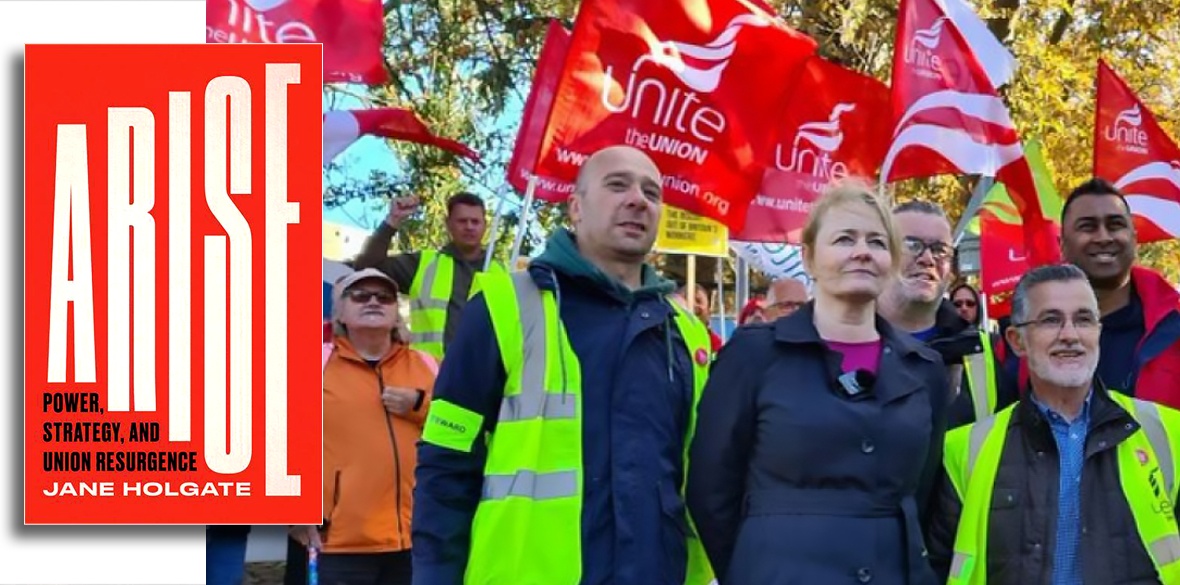This is the last article you can read this month
You can read more article this month
You can read more articles this month
Sorry your limit is up for this month
Reset on:
Please help support the Morning Star by subscribing here
Arise: Power, Strategy and Union Resurgence
Jane Holgate
Pluto Press, £16.99
TAKING her cue from Hobsbawm’s analysis of the decline in trade union power, Holgate seeks to address the same problem — namely why trade union power has continued to decline since 1979, and whether this means that trade unionism in the 21st century requires “a fundamental rethink about the structure and strategy of trade union organising.”
Holgate’s book centres on how trade unions organise and the main organising models that have been adopted during the past 40 or so years in response to union decline.
She analyses these models and finds them deficient in that they ignore what, for her, is the vital question — the locus of power.
This negligence has meant that what she terms transformational change is not, and has never been, on the agenda.
However, the framing of the problem in this way begs the question as to whether trade unions can or should be the vehicle for such change.
For Marxists real transformational change means ending capitalism and achieving socialism — a goal well beyond the raison d’etre of trade unions.
But Holgate is not a syndicalist and thus her definition of transformational change is more limited — it is to “embed trade unionism in the social and cultural arenas of society” in addition to augmenting unions’ collective control over wages and conditions.
For this there has to be a different approach to trade unionism — deep organising of the “whole worker” rather than what she terms the shallow organising, based simply on recruiting new members — which has characterised the existing models.
Oddly, this more radical conception of organising fits neatly with Holgate’s less radical understanding of power, a concept which for her is not to be confused with state power. (Presumably, although unstated, she regards the capture of state power as the purview of a revolutionary political party).
Instead, favouring Allan Flanders in preference to Marx, she echoes the former who suggests that “unions need both power and vitality to achieve their social purpose” — the only example she gives of this is action to combat climate change and campaigning for a “green transition.”
This somewhat limited construal of “power” is logically consistent with a non-syndicalist view, albeit the goal of “social” unionism needs to be taken seriously.
Together with “deep organising” at the points of production and consumption, Holgate offers a much-needed strategic vision for union renewal.
She enthusiastically embraces the concept of class struggle as a vehicle to win her renewal strategy. But this, she acknowledges, can only succeed through raising the level of class consciousness, to be attained through political education, accompanied by whole-worker “deep organising” unmediated by full-time officials.
The professionalisation and bureaucratisation of trade unions is an anathema to Holgate. Strangely she identifies the origin of this process with the 1968 Donovan Report, commissioned during the 1964-70 Labour government to combat “wildcat strikes.”
Despite the fact that Donovan laid the foundation of many of the trade union reforms of the 1970s (all subsequently reversed by Thatcher), Holgate sees the acceptance of the report as having undermined the role of the shop steward and with it workplace collective bargaining, replacing it instead with professionalised negotiating and “a seat at the table.”
Hence, she argues, that rank-and-file membership activity was already demobilised in the 1970s pre-Thatcher with later disastrous consequences post-1979.
After 1979 the Tories abolished tripartism, launched a massive legal attack on every aspect of trade unionism and inflicted major defeats on the strongholds of union organisation — miners, printers and dockers.
The TUC and its affiliates responded with various “new realist” strategies coalescing around the “servicing” and “organising” models.
Both, in her view, are predicated on membership passivity — the assumption being that members join unions because, as consumers, they want to know what the union can do for them and not vice versa.
Holgate cites RMT as an example of a union which, in rejecting the organising model, has nonetheless increased its membership through an ideological class-based, shop steward-led approach which recognises that the struggle is between capital and labour.
This is what the “new unionism” of the 1880s understood. Inspired by socialist leaders like Tom Mann and Eleanor Marx, trade unions took root among previously unorganised unskilled and semi-skilled workers — many, like the dockers, were on zero-hours contracts.
The parallels today with “hard-to organise” gig economy workers are obvious. Class consciousness, political education, building from the base are all crucial elements in achieving union growth. It is clear that existing strategies have had a limited success in stemming decline.
Holgate’s thoughtful book offers an alternative strategic vision, well worthy of serious attention.
MARY DAVIS









